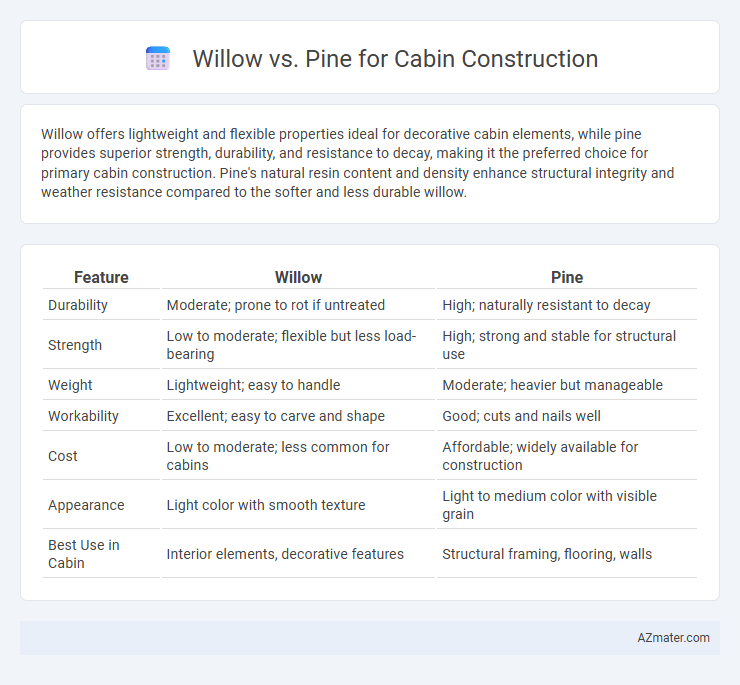Willow offers lightweight and flexible properties ideal for decorative cabin elements, while pine provides superior strength, durability, and resistance to decay, making it the preferred choice for primary cabin construction. Pine's natural resin content and density enhance structural integrity and weather resistance compared to the softer and less durable willow.
Table of Comparison
| Feature | Willow | Pine |
|---|---|---|
| Durability | Moderate; prone to rot if untreated | High; naturally resistant to decay |
| Strength | Low to moderate; flexible but less load-bearing | High; strong and stable for structural use |
| Weight | Lightweight; easy to handle | Moderate; heavier but manageable |
| Workability | Excellent; easy to carve and shape | Good; cuts and nails well |
| Cost | Low to moderate; less common for cabins | Affordable; widely available for construction |
| Appearance | Light color with smooth texture | Light to medium color with visible grain |
| Best Use in Cabin | Interior elements, decorative features | Structural framing, flooring, walls |
Introduction: Choosing Between Willow and Pine for Cabins
Willow and pine are two popular choices for cabin construction, each offering unique benefits. Willow wood is known for its lightweight and flexible properties, making it ideal for eco-friendly, sustainable cabins. Pine, on the other hand, provides durability, resistance to decay, and a classic rustic appearance, favored for long-lasting cabin structures.
Wood Characteristics: Willow vs Pine
Willow wood is lightweight and flexible, offering moderate durability but lower resistance to decay and insect damage compared to pine. Pine wood is denser, stronger, and naturally resistant to rot and pests, making it highly suitable for structural elements in cabin construction. Pine's straight grain and ease of treatment enhance its longevity and structural integrity, whereas willow's softer texture limits its use primarily to non-load-bearing components.
Strength and Durability Comparison
Pine is widely preferred in cabin construction due to its greater strength and durability, featuring a dense grain structure that resists warping and holds fasteners securely. Willow, while lighter and more flexible, lacks the hardness of pine, making it less suitable for load-bearing structures and long-term exterior use. Pine's resistance to decay and ability to withstand harsh weather conditions ensures structural integrity and longevity in cabin builds, outperforming willow in most durability metrics.
Weather Resistance and Longevity
Pine is generally preferred over willow for cabin construction due to its superior weather resistance and durability, with natural oils and resin content that protect against moisture, insects, and decay. Willow lacks the dense grain structure and protective compounds found in pine, making it more susceptible to rot and warping in fluctuating weather conditions. Consequently, pine cabins typically offer longer longevity and require less frequent maintenance than those built with willow.
Workability and Construction Ease
Willow wood is lightweight and easy to cut, making it highly workable for cabin construction, especially for intricate carpentry tasks. Pine, known for its straight grain and uniform texture, offers excellent ease of construction with minimal splitting and good nail-holding capacity. Both woods provide versatility, but pine's durability and availability often make it a preferred choice for efficient cabin building projects.
Insulation Properties: Thermal and Acoustic
Willow wood offers moderate thermal insulation but is less dense, resulting in lower acoustic insulation compared to pine, which has a tighter grain structure that enhances both thermal retention and soundproofing. Pine's higher resin content also contributes to better moisture resistance, indirectly improving insulation efficiency by reducing potential dampness. For cabin construction where both thermal and acoustic insulation are priorities, pine is generally the superior choice due to its durability and insulating properties.
Environmental Impact and Sustainability
Willow wood offers rapid growth and high carbon sequestration, making it a highly sustainable choice for cabin construction with minimal environmental footprint. Pine, while slower growing, is durable and widely available, supporting sustainable forestry practices through responsible harvesting and replanting programs. Both materials provide renewable resources, but willow's fast renewability and lower ecological impact give it an edge in environmentally conscious building projects.
Cost Analysis: Willow vs Pine
Pine is generally more cost-effective for cabin construction due to its wide availability, faster growth rate, and consistent supply, resulting in lower market prices compared to willow. Willow tends to be more expensive because of its limited commercial use in structural applications and higher processing costs to enhance durability and stability. When considering long-term expense, pine's superior strength and resistance to decay typically reduce maintenance costs, offering better overall value for cabin builders.
Aesthetic Differences and Design Options
Willow wood offers a light, smooth texture with subtle grain patterns that lend an airy, rustic charm to cabin interiors, ideal for modern and minimalist designs. Pine features a more pronounced grain and warm yellowish tones, providing a classic, cozy aesthetic perfect for traditional or country-style cabins. Designers often choose willow for sleek, contemporary looks, while pine is favored for creating inviting, natural atmospheres with versatile finishes.
Conclusion: Best Choice for Cabin Construction
Pine is the best choice for cabin construction due to its superior strength, durability, and natural resistance to rot and insects, ensuring long-term structural integrity. Willow lacks the density and resilience necessary for load-bearing applications, making it less suitable for exterior framing or siding. Selecting pine enhances overall cabin stability and reduces maintenance costs over time.

Infographic: Willow vs Pine for Cabin Construction
 azmater.com
azmater.com